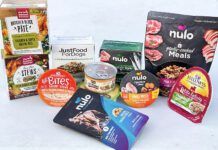Home Search
raw dog food - search results
If you're not happy with the results, please do another search
Best Dog Food Toppers
Dog food toppers are an excellent way to enhance your dog’s meals, whether to add variety to mealtimes, provide additional nutrition, or support specific health conditions. When it comes to toppers, you can choose from simple, homemade additions like lightly cooked meats and vegetables to commercially available wet and freeze-dried toppers designed to provide targeted nutritional support.
Can Dogs Eat Cat Food?
If your dog snatches a little cat food occasionally, his biggest risk is getting a swat on the nose from your irritated cat.
Unleashing the Truth: The Benefits and Science Behind High-Protein, Low-Carb, and Ketogenic Dog Food
As the field of canine nutrition continues to evolve, more pet owners are turning their attention to diets that mimic the natural eating habits of dogs' wild ancestors: diets that are high in protein and fat, and low in carbohydrates
Whole Dog Journal’s Approved Canned Dog Foods
Here you’ll find a list of pet food companies that make the kind of foods that meet our canned dog food selection criteria. We’ve included ALL the information we gathered from each company on our approved foods list. Here’s the most exciting part about the table, however: It’s a searchable database that you can use to find appropriate foods for your dog!
Finding The Best Large-Breed Puppy Food
Choosing a food for a new puppy is always a bit worrisome, but for those who adopt large or giant breed pups, selecting the...
Concerns about Homemade Dog Food Recipes
One of the biggest challenges with homemade dog food is the inconsistency of nutrient content in raw ingredients. Ingredients such as meats, vegetables, and grains can vary widely in nutrient content depending on their growing conditions, seasonality, source, storage conditions, and processing methods.
Dog Food for Sensitive Stomachs
The term “sensitive stomach” refers to a variety of gastrointestinal issues that can impact dogs of all breeds, age, and size. For dogs with sensitive stomachs, meals can cause discomfort and distress. Digestive issues can negatively impact our pet’s quality of life and leave many owners searching for a solution to help alleviate their dog’s digestive issues.
The Best Food for Small Dogs
There may be some benefits to feeding your little dog a diet specifically formulated to target many of the issues small breeds face. When looking at labels for healthy dog foods for small dogs, consider these elements:
Dog Food for Skin Allergies
If your dog suffers from skin allergies, choosing the right food can make a difference for your dog’s comfort and health. Allergies in dogs are a common concern from pet owners and can cause itchiness, red patches, hair loss, inflammation, and secondary skin infections.
When Can Puppies Start Eating Hard Food?
Understanding when and how to introduce hard food is important as it can influence your puppy’s health, growth, and overall well-being. Most puppies can start transitioning to solid foods between 3 and 4 weeks of age.
Dog Food’s Effect on Yeast Infections and Severe Allergies
A growing body of evidence highlights the significant role that diet plays in either aggravating or alleviating the underlying causes of allergies and yeast infection. However. it’s not a one-for-all dog food choice.
Low-Fat Dog Food for Weight Management
The best dog food to help dogs lose weight is one that is formulated to provide fewer calories per serving, while still meeting the minimum requirements of essential nutrients.













